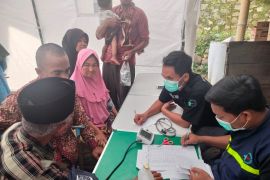Health Minister's Special Staff for Drug and Medical Device Resilience, Laksono Trisnantoro, delivered the statement at the webinar "National Forum for Independence and Resilience of the Pharmaceutical Procurement Industry" here on Monday.
"In September 2021, the health minister had sent a letter to the industry minister that the use of TKDN for 23 drugs, whose raw materials are available in the country, be increased to 55 percent," Trisnantoro stated.
Related news: Legislator calls on government to reform pharmacy waste management
Through Presidential Instruction No. 6 of 2016 on accelerating the development of the Pharmaceutical and Medical Devices Industry and Industry Minister's Regulation No. 16 of 2020 on How to Calculate the Value of TKDN, the TKDN of pharmaceutical raw materials are pegged at 50 percent.
"Since 2020, it turns out that the implementation of TKDN is still weak. Most of the pharmaceutical industry's TKDN is still at around 30 to 40 percent," he noted.
He cited the example of products, such as clopidogrel drugs. He noted that on an average, pharmaceutical companies produced this drug, with a TKDN of about 30-40 percent.
Related news: Indian pharmacy firms show interest in investing in Central Java
Only state-owned pharmaceutical firm Kimia Farma in Banjaran and its sub-holding PT Phapros Indonesia had succeeded in producing the drug, with a TKDN of 68.19 percent and 68.92 percent, respectively.
In future, Trisnantoro affirmed that the Ministry of Health will encourage the pharmaceutical industry to boost its domestic component level of products on an annual basis. He reasoned that the TKDN of industries in other sectors, such as pipelines and mining, had continued to increase.
"We will use this model, so that the procurement of pharmaceutical products can be targeted with a certain TKDN. For instance, if the production of insulin can be targeted within five to 10 years, then its TKDN is already 75 percent," he remarked.
Related news: Indonesian pharmaceuticals enter Polish market with diabetes drugs
Moreover, Trisnantoro is optimistic that the pharmaceutical industry's players would also be encouraged to utilize their research funds, with a good time frame, so that the TKDN targets can be achieved.
"For researchers, the government offers incentives to develop products, make formulations, and conduct research related to improving the nation's drug capabilities and bioequivalence," he expounded.
The implementation of TKDN is also believed to be effective in making the domestic pharmaceutical industry more independent. In 2020, some 90 percent of the drug raw materials were still imported.
Related news: West Java athlete secures first swimming gold in Papua Peparnas
Related news: Riau Islands records zero fresh COVID-19 case: Task Force
Translator: Sanya S, Kenzu T
Editor: Fardah Assegaf
Copyright © ANTARA 2021











